How Technology Can Automate Nonprofit Operations: 3 Benefits

From prospect research to volunteer management to mobile bidding for an auction event, technology can streamline and completely automate many aspects of your nonprofit’s operations. Tech-savvy nonprofits have already begun to experience the benefits of modern nonprofit software, saving their teams time, resources, and stress.
Speeding up your team’s workflow is just one of the benefits technology and automation can bring nonprofits. To determine if your nonprofit should upgrade its software and what you can gain from doing so, this guide will explore three major benefits of nonprofit technology.
1. Supporter self-service tools
Technology allows you to decentralize parts of your operations and put more power in your supporters’ hands. Self-service tools let your donors manage various parts of their engagement, such as how often they give, what activities they want to participate in, and how they prefer to be contacted.
While self-service tools do mean ceding some control of your donor management, they more than make up for it with the following benefits:
- Save your team time. When a recurring donor who gives to a nonprofit without self-service tools wants to make a change to their donation cadence, they need to call or email a member of your team to make the change. Self-service tools are far more practical for enterprise-sized organizations with thousands of donors.
- Empower donors to manage their engagement. Letting supporters take control of their engagement can make them feel like more active participants in your nonprofit, increase trust, and boost donor retention. Plus, supporters know when certain changes must be made to their donor profile. For example, if a supporter knows their credit card is about to expire, they can make the update in their profile far faster than your team could.
- Allow supporters to talk to one another. Self-service tools can include more than just editable profiles. For example, Fionta outlines how Salesforce Experience Cloud can be used to create online experiences for nonprofit members, including self-service portals. Specifically, nonprofits can build online message boards that enable supporters to reach out to one another and answer each other’s questions about volunteering, upcoming events, or any other opportunities at your organization.
Self-service tools make donor management easier for both your team and your supporters. Additionally, creating a member portal for supporters can be the first step to building out a more thorough online engagement strategy.
Along with handling basic aspects of their engagement, such as updating addresses and payment information, consider how else your supporters may want to interact with you online. For example, you might create webinars and blog posts accessible only to donors or encourage donors to connect with one another on your message boards to form a community.
2. Compliance management
Nonprofit organizations must adhere to government regulations and complete reports to demonstrate compliance. Many nonprofit software managing and reporting systems include features that streamline compliance reporting.
Common features that improve compliance management include:
- Organized databases. Maintaining compliance is simple when your nonprofit has all the data you need on hand and in an organized system. Use CRMs and donor databases that are highly customizable, like Salesforce, to create custom organization systems and reports to make your data easier to retrieve.
- Reporting templates. Specialized software for various causes often comes with reporting templates and can automatically generate specific parts of your reports. For example, software developed for nonprofit organizations dedicated to fighting homelessness may come with features to help users report to the Department of Housing and Urban Development.
- Automatic alerts. Keep your team on track to hit reporting deadlines by implementing automatic alerts. These can help manage your team’s schedules and improve accountability by ensuring everyone does their part to help you complete your compliance reporting.
Your software can also help you maintain financial compliance. For example, nonprofits filling out their Form 990 can benefit from automatic bookkeeping tools, while foundations often use grants management software to ensure they spend the correct percentage of their funds to remain a 501(c)(3).
3. Improved data management
Your nonprofit gathers data every time you interact with donors, launch an initiative, hire a volunteer, and send out an email. This information can be essential for understanding your organization’s current performance and optimizing your future strategy.
Invest in a CRM with strong donor management capabilities that allow you to collect and manage your supporters’ data at scale. Choose a system that enables you to easily:
- Track donor information. The more you know about your donors, the better you’ll be able to connect with them. NPOInfo’s guide to nonprofit data collection recommends gathering the following information about your donors: name, age, contact information, employment status, educational background, giving history, advocacy participation, business, connections, and interests. Use your CRM to create tags you can add to donor profiles to highlight particularly important donor information, such as a connection to a business you are interested in getting sponsorship from.
- Make data-driven decisions about donors. Nonprofit CRMs have started experimenting with analytics AI tools that can provide recommendations for the best ways to engage donors. For example, the AI might look at a donor’s giving history and recent engagement rate to advise when to ask them for a donation upgrade and how much that upgrade should be.
- Maintain improved data hygiene. Your data is only useful if it’s correct and up-to-date. Fortunately, nonprofits can use several apps and add-ons to help manage their databases. For example, many nonprofits use a deduplication tool that identifies duplicate records. With these duplicate records compiled automatically, your team can decide to delete or merge a record.
These are just a few ways nonprofits can use their data. Email tools can help nonprofits build message templates and auto-populate them with relevant donor information, prospect research tools can flag potential major giving candidates, and matching gift software can automatically pair donors with their employers’ matching gift program information.
Nonprofit operations are often complex, but technology can streamline routine tasks, allowing your team to focus on work that requires a human touch. Explore how you can use technology to make interacting with your nonprofit a more convenient and engaging experience for your donors.


